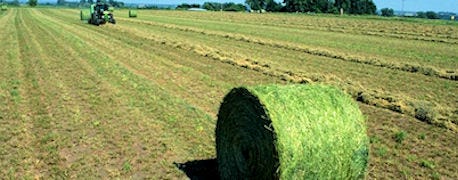August 13, 2012

Marvin Hall, Extension forage agronomist at Penn State University, is hoping for an extended autumn with rain to make up for some of this year's shortfall in hay. With fields in poor condition over the summer, the hay crop has taken a hit.
"We had two good cuttings that produced 50 to 60% of the seasonal yield of a regular year," Hall says. "So we're at about 60% of where we should be."

HANDLE WITH CARE: Preserving hay quality – and quantity – will carry a premium value this fall and winter since the Midwest won't have a back-up supply for the Northeast. Photo courtesy of Pioneer Hi-Bred
In a more normal year with sufficient rainfall, farmers would harvest 250 small square bales – 40 pounds each – per acre over the entire season, with 175 bales per acre harvested by this time of the year. However, the drought conditions have meant that currently, only 100 bales per acre have been harvested.
"If we have a long fall and the pasture is managed right, the animals could graze until mid- to early November," he adds. "If we have a frost or snow in mid-October, that's an extra 30 days the farmer has to feed dry hay that they don't have. That'll increase costs."
Current hay prices are around $250 per ton. Last year, when Pennsylvania went through a similar shortfall situation, prices reached $400 to $500 per ton. Hall wouldn't be surprised to see those prices again.
In a normal year, hay would be shipped to Pennsylvania and the Northeast from the Midwest. However, Hall says that region is also in trouble, so the severe drought there will mean that not much hay will be available for importing either.
Hall expects livestock producers will have enough to fill their needs. But the year still won't be easy.
You May Also Like




